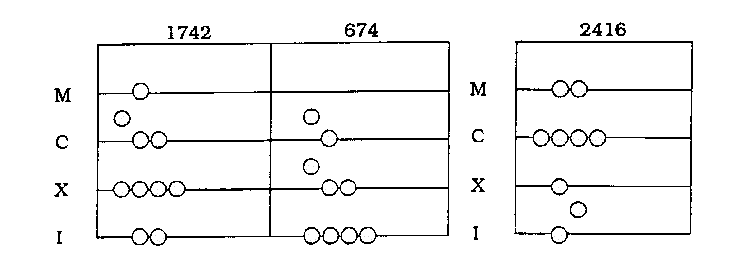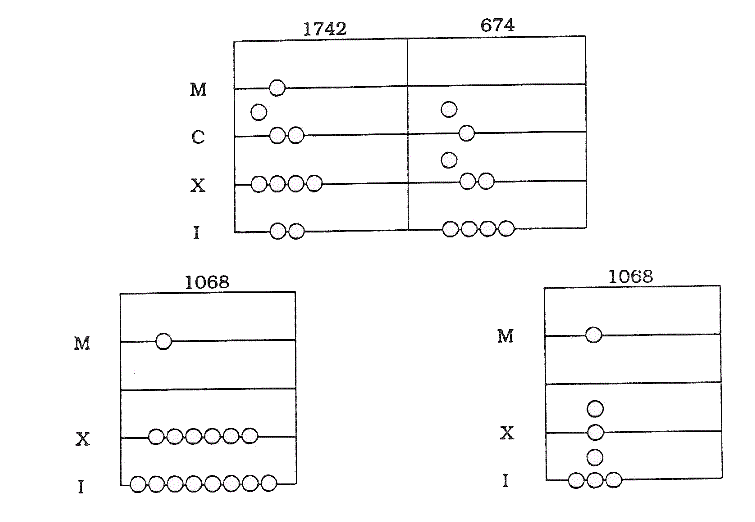The abacus, on which the jettons were placed, could vary considerably. It could be a special cloth embroidered with squares or lines, a wooden board rather similar to a shove ha'penny board or just lines marked on a table. It could also vary in size, depending on how many people needed to see the accounts being reckoned: the English Exchequer table being 10' x 5'.
Although there were many ways of laying out the counters, a simple method is illustrated.

The illustration shows a reckoning board with jettons laid out to perform an addition. The horizontal lines represent units or multiples of ten, the spaces between the lines are used for 5, 50, 500 etc. To represent the first part of the addition (1742) requires 10 jettons:
| 1 | x | 1 | 0 | 0 | 0 |
| 1 | x | 5 | 0 | 0 | |
| 2 | x | 1 | 0 | 0 | |
| 4 | x | 1 | 0 | ||
| 2 | x | 1 |
To represent the second sum to be added (674) requires a further 9 jettons:
| 1 | x | 5 | 0 | 0 | |
| 1 | x | 1 | 0 | 0 | |
| 1 | x | 5 | 0 | ||
| 2 | x | 1 | 0 | ||
| 4 | x | 1 |
To add the two together the jettons on each line are pushed together, starting from the bottom line, and working upwards. There are two basic rules to be observed: no more than four jettons on a line (i.e. representing 4 or 40 etc) and no more than one jetton between a line (i.e. representing 5 or 50 etc). In the example because we would have 6 jettons on the unit line, we have to take five away and replace them with one in the 5 position. Similarly because there are six jettons on the 10 line we have to replace 5 by one in the 50 position. However we now have 2 x 50 so these are replaced by 1 x 100. When the top line is reached there should be 9 jettons left on the board to represent the total of 2416:
| 2 | x | 1 | 0 | 0 | 0 |
| 4 | x | 1 | 0 | 0 | |
| 1 | x | 1 | 0 | ||
| 1 | x | 5 | |||
| 1 | x | 1 |
The method of subtraction is very similar.

This time we work down from the highest numbers removing jettons as each line is completed.
Hence 1000's no change
500's 1 minus 1 = 0
100's 2 minus 1 = 1
To subtract 70 from 40 take one jetton from the 100 line and add three to the 10 line. Finally to subtract 4 from the smaller number take one from the 10 line and add 6 to the units. On tidying the board to avoid having too many jettons on a line we finish up with the result on the right. Multiplication could be done either by multiple addition, or by the use of multiplication tables. Division was also possible using jettons, but was even more complicated.